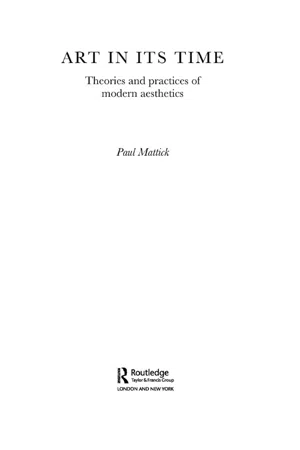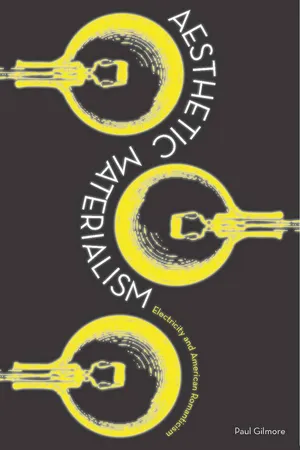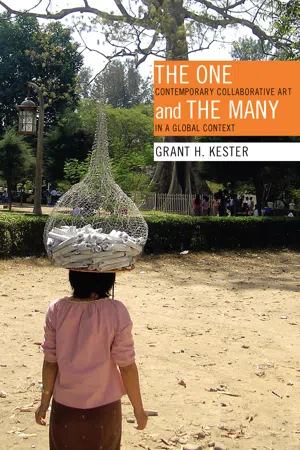Literature
Anti-Aestheticism
Anti-aestheticism refers to a rejection of traditional aesthetic values and an embrace of the unconventional, the ugly, and the mundane in literature. It challenges the idea that art should be beautiful and instead seeks to disrupt and provoke. Anti-aestheticism often aims to critique societal norms and challenge the status quo through its rejection of traditional aesthetic principles.
Written by Perlego with AI-assistance
Related key terms
1 of 5
3 Key excerpts on "Anti-Aestheticism"
- eBook - ePub
Art In Its Time
Theories and Practices of Modern Aesthetics
- Paul Mattick(Author)
- 2003(Publication Date)
- Routledge(Publisher)
52The present-day conservatism of philosophical aesthetics (the articles in a publication like the American Society for Aesthetics’s Journal of Aesthetics and Art Criticism are as irrelevant to contemporary art today as when Newman complained about philosophical detachment from the art world struggle over aesthetic legitimacy and significance) is itself a symptom of the ongoing transformation of the practice of art signaled by the rise of the anti-aesthetic. Art, once securely positioned as the highest secular religion of modern society—higher than science, for all practical purposes, because it is both more accessible to the nonspecialist and freer of the taint of commercial (not to mention military) utility— has now become an area of confusion and contestation. The taking up of this field of production and consumption, and in particular of the avant-garde area within it, by institutions of state and academy, together with the enormous and rapid expansion of the market for art, have done much to erode the earlier conception of art as founded on the transcendence of social particularity achieved by the heroic, creative individual.At the same time, the importance of the role of the practice of art in the development of modern society, visible in the use of the museum and concert hall as reliquaries for the material embodiments of its “higher self,” means that it remains with us despite the ever more apparent incoherence of its conceptual structure. As a result of this practice’s continuing life, even attempts to question basic elements of aesthetic ideology can function in the struggle for art world legitimacy and commercial success. For example, the success of “postmodern” critics and artists in defining “feminist art” in terms of the use of non-traditional media has made possible the creation of an artistic (and marketing) niche for critical women’s work, while also largely accepting as a given the centuries-old definition of painting—still the core (and highest priced) commodity of the art business—as masculine, despite the activity of women and feminist painters.53 - eBook - ePub
Aesthetic Materialism
Electricity and American Romanticism
- Paul Gilmore(Author)
- 2009(Publication Date)
- Stanford University Press(Publisher)
3Where the return to aesthetics in literary criticism in the last decade has been described as a kind of new formalism, a revival of formalism, or a recovery of the formalism implicit to much new historicism and cultural studies, it is important to distinguish formal approaches from aesthetics in avoiding a reduction of aesthetics to aestheticization.4 Thus, even as a new aesthetics addresses questions of literary form, we need to recognize form as merely one element in the intersection of audience, world, and text that might yield or help to articulate aesthetic experience. Historically, in fact, “aesthetics” in the United States did not refer to an explicitly apolitical sphere, the apotheosis of literary form, or a specific artistic canon of great works. Nineteenth-century critics often assailed transcendentalist aesthetics for neglecting these very areas. Only sparingly used in American publications of the 1820s and the 1830s to refer broadly to the study of the arts, “aesthetics,” by the 1840s, began to be used more frequently to evoke the dangers of an approach to both art and life connected with romanticism and German idealism.5 Critics worried that, with its focus on the individual, subjective judgment rather than on the critic’s or artist’s role as cultural arbiter, aesthetics abandoned the moral and political project of literature. The American Whig Review , for example, devoted its 1846 review of Margaret Fuller’s volume of essays Papers on Literature and Art to describing this “new kind of criticism—aesthetic criticism.” In summation, the review dismissed Fuller’s essays and their aesthetic critical method by noting that “There is nothing in them of the practical; nothing is said of counter-point, or chiaro-oscuro, subject or composition, style or choice of words.” Rather than accounting for the mechanical workings of art and guiding the tastes of the uninstructed, Fuller—with the “transcendental school” that “embrac[ed] the new aesthetic method of criticism”—simply “affects to discover and reproduce the veritable spirit of an author or literature.” 6 - eBook - PDF
The One and the Many
Contemporary Collaborative Art in a Global Context
- Grant H. Kester(Author)
- 2011(Publication Date)
- Duke University Press Books(Publisher)
. . . This means primarily that words, having the initiative, are not obliged to serve to designate anything or give voice to anyone, but that they have their ends in themselves. MAURICE BLANCHOT, THE SPACE OF LITERATURE The Aesthetic Education provided a template that has been followed by subsequent critics and theorists with remarkable devotion, as each ele-ment is retained and rearticulated. We might consider the parallel with Clement Greenberg’s notion of formal “movement” in the development of avant-garde art in the post–Second World War period (as the sublimated expression of a currently unrealizable political movement). For Green-berg, and many American artists during the early years of the Cold War, substantive political change was blocked by the impasse between a tar-nished communism and a reviled capitalist consumer culture.50 As a re-sult, the only option available was retreat into the protected enclave of the canvas, where the artist could preserve the freedom necessary for un-constrained aesthetic play. Schiller’s aesthetic finds a more contemporary expression in the dilemma of French intellectuals and artists in the late 1960s. Here the impossibility of positive political change (embodied in the perceived failure of May ’68) legitimated a withdrawal into a zone of sub-versive textual play and écriture . Each of these cultural moments proceeds via a conservational displacement or deferral of political critique into a more abstract critique of epistemology per se , evident in Greenberg’s at-tack on representational art and Roland Barthes’s attack on conventional forms of signification. Peter Starr, in his illuminating intellectual history of May ’68, iden-tifies a “logic of failed revolt” that informed the thinking of the genera-tion of French theorists who rose to international prominence during the 1970s. Starr traces this logic through the writings of Louis Althusser, Roland Barthes, Hélène Cixous, Gilles Deleuze, Jacques Derrida, Michel
Index pages curate the most relevant extracts from our library of academic textbooks. They’ve been created using an in-house natural language model (NLM), each adding context and meaning to key research topics.


